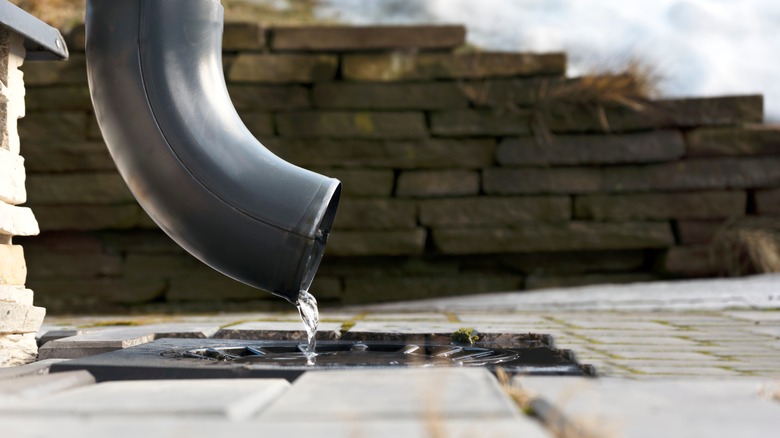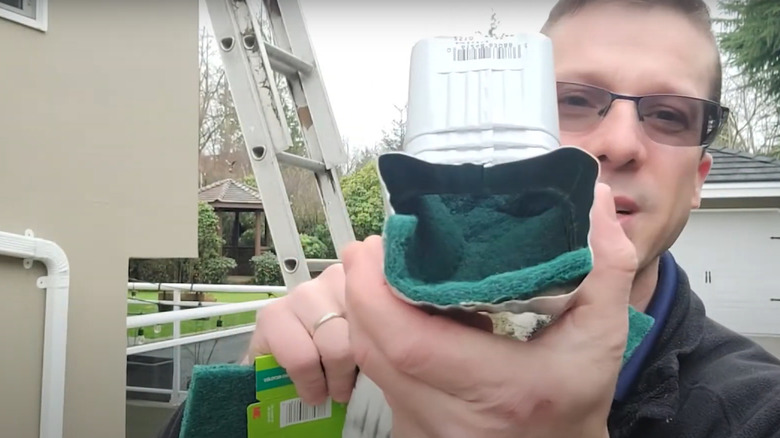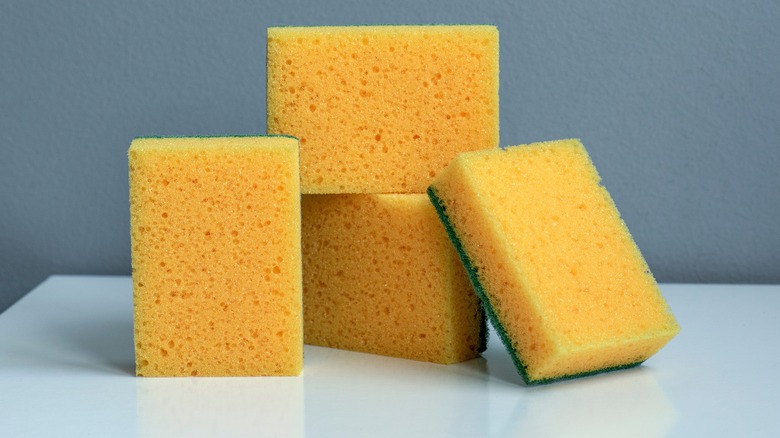How To Use A Kitchen Sponge To Silence Your Drippy Downspout
Rainy days have a certain charm to them. The rhythmically falling raindrops and the earthly aroma have the power to soothe one's soul. However, the serene tranquility can quickly dissipate when the pitter-patter changes to the persistent drip-drop from a leaky downspout. A drippy downspout is often a result of rainwater encountering debris in its path, which inhibits its free flow and causes it to drip slowly. This gradual pace forces the water to hit the gutter's elbow instead of flowing directly, leading to an annoying noise, which is exponentially louder with metal pipes.
Mostly common among bottom-curved and rectangular downspouts, repositioning its angle should help quiet your system, as the rainwater will hit its side and not the elbow. But when that fails, using an ordinary kitchen sponge in your gutter's bottom can help quickly fix the pesky drip. Owing to its absorbent properties, a sponge easily soaks up slow-moving water and eliminates unwanted loud sounds.
Fixing the dripping noise with a sponge
Even though using a sponge to silence your drippy downspout may seem unconventional, it is very effective. Start by gathering all the necessary supplies, including a clean, dry kitchen sponge, scissors, and a strong adhesive like PL glue. Moreover, get a ladder if your downspout is out of reach.
After collecting the supplies, trim down your kitchen sponge using scissors to a size that can snugly fit into the gutter's opening. The aim is to have a size large enough to absorb the dripping rainwater easily, while still allowing plenty of open pipe space, so as to avoid any blockages from debris. Then, apply the glue to the sponge's scrub surface and push it gently into the downspout opening. This should help keep the kitchen staple in place even during heavy water flow. Wait for the next rain and see the magic unfold. Your household multitasker will successfully muffle all trickling water sounds.
Pros and cons of using sponges
While several absorbent material options — such as artificial turf, shingles granules, and foam inserts — can be used to hush the troublesome droplets, scrubber sponges come out on top. Being a kitchen staple, they are easy to grab whenever the frustrating drips become too loud. They are also priced inexpensively, enabling you to fix the noise without burning a hole in your pocket. Using sponges is a convenient DIY solution that quickly addresses the leaky downspout issue, providing relief within minutes — not to mention their excellent porosity easily mutes the annoying water droplet symphonies while enabling smooth water flow.
But as the sponge soaks up water over time, it may develop mold, a serious safety concern that can jeopardize your health. So, depending on the frequency of rain and the sponge's absorbency, you must replace it periodically for effective results. For a more effective approach, prioritize stronger, long-term solutions that treat the underlying causes, like insulating the downspout system, swapping out the metal for PVC elbows, or installing fiberglass gutters.


